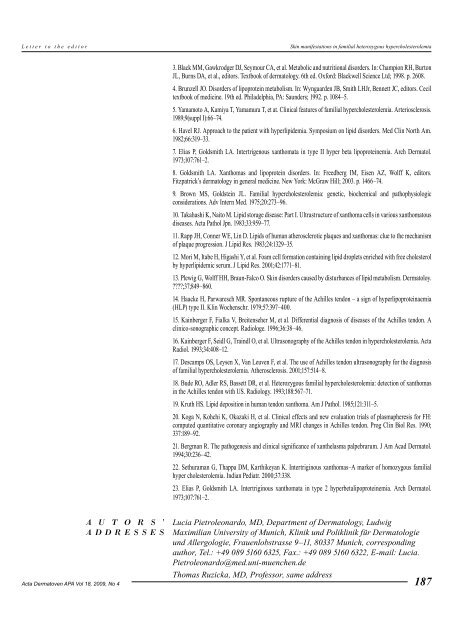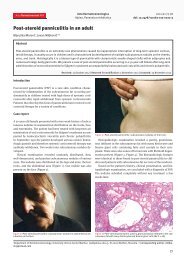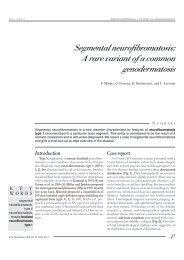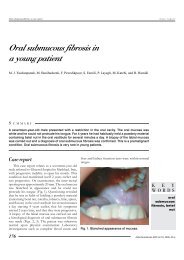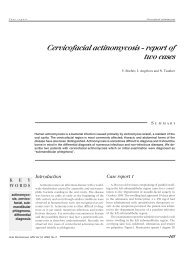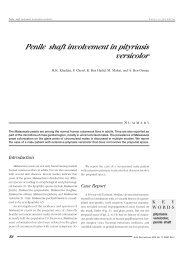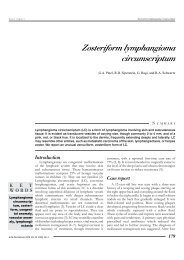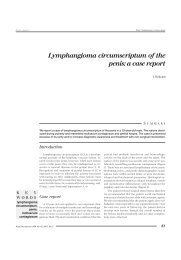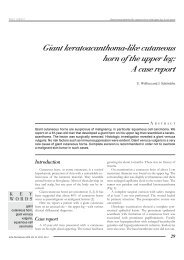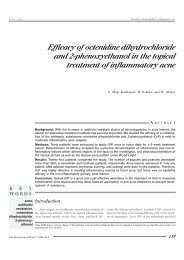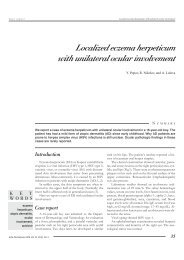Skin manifestations in familial heterozygous hypercholesterolemia
Skin manifestations in familial heterozygous hypercholesterolemia
Skin manifestations in familial heterozygous hypercholesterolemia
- No tags were found...
You also want an ePaper? Increase the reach of your titles
YUMPU automatically turns print PDFs into web optimized ePapers that Google loves.
Letter to the editor<strong>Sk<strong>in</strong></strong> <strong>manifestations</strong> <strong>in</strong> <strong>familial</strong> <strong>heterozygous</strong> <strong>hypercholesterolemia</strong>3. Black MM, Gawkrodger DJ, Seymour CA, et al. Metabolic and nutritional disorders. In: Champion RH, BurtonJL, Burns DA, et al., editors. Textbook of dermatology. 6th ed. Oxford: Blackwell Science Ltd; 1998. p. 2608.4. Brunzell JO. Disorders of lipoprote<strong>in</strong> metabolism. In: Wyngaarden JB, Smith LHJr, Bennett JC, editors. Ceciltextbook of medic<strong>in</strong>e. 19th ed. Philadelphia, PA: Saunders; 1992. p. 1084–5.5. Yamamoto A, Kamiya T, Yamamura T, et at. Cl<strong>in</strong>ical features of <strong>familial</strong> <strong>hypercholesterolemia</strong>. Arteriosclerosis.1989;9(suppl I):66–74.6. Havel RJ. Approach to the patient with hyperlipidemia. Symposium on lipid disorders. Med Cl<strong>in</strong> North Am.1982;66:319–33.7. Elias P, Goldsmith LA. Intertrigenous xanthomata <strong>in</strong> type II hyper beta lipoprote<strong>in</strong>emia. Arch Dermatol.1973;107:761–2.8. Goldsmith LA. Xanthomas and lipoprote<strong>in</strong> disorders. In: Freedberg IM, Eisen AZ, Wolff K, editors.Fitzpatrick’s dermatology <strong>in</strong> general medic<strong>in</strong>e. New York: McGraw Hill; 2003. p. 1466–74.9. Brown MS, Goldste<strong>in</strong> JL. Familial <strong>hypercholesterolemia</strong>: genetic, biochemical and pathophysiologicconsiderations. Adv Intern Med. 1975;20:273–96.10. Takahashi K, Naito M. Lipid storage disease: Part I. Ultrastructure of xanthoma cells <strong>in</strong> various xanthomatousdiseases. Acta Pathol Jpn. 1983;33:959–77.11. Rapp JH, Conner WE, L<strong>in</strong> D. Lipids of human atherosclerotic plaques and xanthomas: clue to the mechanismof plaque progression. J Lipid Res. 1983;24:1329–35.12. Mori M, Itabe H, Higashi Y, et al. Foam cell formation conta<strong>in</strong><strong>in</strong>g lipid droplets enriched with free cholesterolby hyperlipidemic serum. J Lipid Res. 2001;42:1771–81.13. Plewig G, Wolff HH, Braun-Falco O. <strong>Sk<strong>in</strong></strong> disorders caused by disturbances of lipid metabolism. Dermatoloy.????;37;849–860.14. Haacke H, Parwaresch MR. Spontaneous rupture of the Achilles tendon – a sign of hyperlipoprote<strong>in</strong>aemia(HLP) type II. Kl<strong>in</strong> Wochenschr. 1979;57:397–400.15. Ka<strong>in</strong>berger F, Fialka V, Breitenseher M, et al. Differential diagnosis of diseases of the Achilles tendon. Acl<strong>in</strong>ico-sonographic concept. Radiologe. 1996;36:38–46.16. Ka<strong>in</strong>berger F, Seidl G, Tra<strong>in</strong>dl O, et al. Ultrasonography of the Achilles tendon <strong>in</strong> <strong>hypercholesterolemia</strong>. ActaRadiol. 1993;34:408–12.17. Descamps OS, Leysen X, Van Leuven F, et al. The use of Achilles tendon ultrasonography for the diagnosisof <strong>familial</strong> <strong>hypercholesterolemia</strong>. Atherosclerosis. 2001;157:514–8.18. Bude RO, Adler RS, Bassett DR, et al. Heterozygous <strong>familial</strong> <strong>hypercholesterolemia</strong>: detection of xanthomas<strong>in</strong> the Achilles tendon with US. Radiology. 1993;188:567–71.19. Kruth HS. Lipid deposition <strong>in</strong> human tendon xanthoma. Am J Pathol. 1985;121:311–5.20. Koga N, Kohchi K, Okazaki H, et al. Cl<strong>in</strong>ical effects and new evaluation trials of plasmapheresis for FH:computed quantitative coronary angiography and MRI changes <strong>in</strong> Achilles tendon. Prog Cl<strong>in</strong> Biol Res. 1990;337:189–92.21. Bergman R. The pathogenesis and cl<strong>in</strong>ical significance of xanthelasma palpebrarum. J Am Acad Dermatol.1994;30:236–42.22. Sethuraman G, Thappa DM, Karthikeyan K. Intertrig<strong>in</strong>ous xanthomas–A marker of homozygous <strong>familial</strong>hyper cholesterolemia. Indian Pediatr. 2000;37:338.23. Elias P, Goldsmith LA. Intertrig<strong>in</strong>ous xanthomata <strong>in</strong> type 2 hyperbetalipoprote<strong>in</strong>emia. Arch Dermatol.1973;107:761–2.A U T O R S 'ADDRESSESLucia Pietroleonardo, MD, Department of Dermatology, LudwigMaximilian University of Munich, Kl<strong>in</strong>ik und Polikl<strong>in</strong>ik für Dermatologieund Allergologie, Frauenlobstrasse 9–11, 80337 Munich, correspond<strong>in</strong>gauthor, Tel.: +49 089 5160 6325, Fax.: +49 089 5160 6322, E-mail: Lucia.Pietroleonardo@med.uni-muenchen.deThomas Ruzicka, MD, Professor, same addressActa Dermatoven APA Vol 18, 2009, No 4 187


